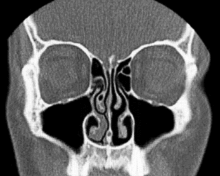Nasal cycle

The nasal cycle is the often unnoticeable[1][2] alternating partial congestion and decongestion of the nasal cavities in humans and other animals. It is a physiological congestion of the nasal concha due to selective activation of one half of the autonomic nervous system by the hypothalamus. It should not be confused with pathological nasal congestion. Although various aspects of the nasal cycle have been studied and discussed in the ancient Yogic literature,[3] in the modern western literature, it was first described by the German physician Richard Kayser in 1895.[4]
Description
In 1927 Heetderks[5] spoke about the alternating turgescence of the inferior turbinates in 80% of a normal population. The cycle is the result of alternating congestion and decongestion of the turbinates, predominantly the inferior turbinates, which are by far the largest of the turbinates in each nasal fossa. Turbinates consist of bony projections covered by erectile tissue, much like the tissues of the penis and clitoris. The turbinates in one fossa filled up with blood while the opposite turbinates decongested by shunting blood away. This cycle, which is controlled by the autonomic nervous system as described above, had a mean duration of two and a half hours. He further observed and documented that the turbinates in the dependent nasal fossa filled when the patient was in the lateral decubitus (lying down) position. Some postulate that this alternating positional obstruction has the purpose of causing a person to turn from one side to the other while sleeping. It has been shown that the cilia of the congested side suspend their motility until that side decongests. Thus the cycle insures that one side of the nose is always moist, to facilitate humidification, which is one of the three functions of the nose, the other two being filtration and warming of inspired air prior to its entering the lungs. The nasal cycle is an alternating one, with the total resistance in the nose remaining constant. In patients with a fixed septal deviation and intermittent nasal obstruction, the interplay of the nasal cycle becomes evident; the sensation of obstruction frequently mirrors the congestion phase.
Distinction
The nasal cycle should not be confused with pathological nasal congestion: individuals with normal nasal breathing usually do not realize their breathing is asymmetric unless there is underlying nasal obstruction.[1] In pathological conditions, however, the nasal cycle may influence the symptoms.[2]
Research on the effects
In 1994, breathing through alternate nostrils showed effects on brain hemisphere symmetry on EEG topography.[6] D.S. Shannahoff-Khalsa published in 2007 on the effect of this cycle and manipulation through forced nostril breathing on one side on the endogenous ultradian rhythms of the autonomic and central nervous system.[7]
References
- ↑ 1.0 1.1 Josephson, J. S. (2006). Sinus Relief Now: The Ground-Breaking 5-Step Program for Sinus, Allergy, And Asthma Sufferers. Penguin Group. p. 15. ISBN 978-0-39953-298-6.
- ↑ 2.0 2.1 Huizing, E. H.; de Groot, J. A. M. (2003). Functional Reconstructive Nasal Surgery. Thieme. p. 52. ISBN 978-1-58890-081-4.
- ↑ Swara Yoga, Swami Mukti Bodhananda, Bihar School of Yoga, December 1999
- ↑ Richard Kayser: Die exakte Messung der Luftdurchgängigkeit der Nase. Arch. Laryng. Rhinol. (Berl.) 8, 101 (1895)
- ↑ Cummings: Otolaryngology: Head & Neck Surgery, 4th ed
- ↑ Stancák A Jr, Kuna M (October 1994). "EEG changes during forced alternate nostril breathing". Int J Psychophysiol (Department of Physiology and Clinical Physiology, Charles University in Prague) 18 (1): 75–9. doi:10.1016/0167-8760(84)90017-5. PMID 7876041.
- ↑ D.S. Shannahoff-Khalsa: Selective Unilateral Autonomic Activation: Implications for Psychiatry. CNS Spectr. 2007, 12(8):625-634